钻头选型方法综述
- 格式:pdf
- 大小:284.03 KB
- 文档页数:6
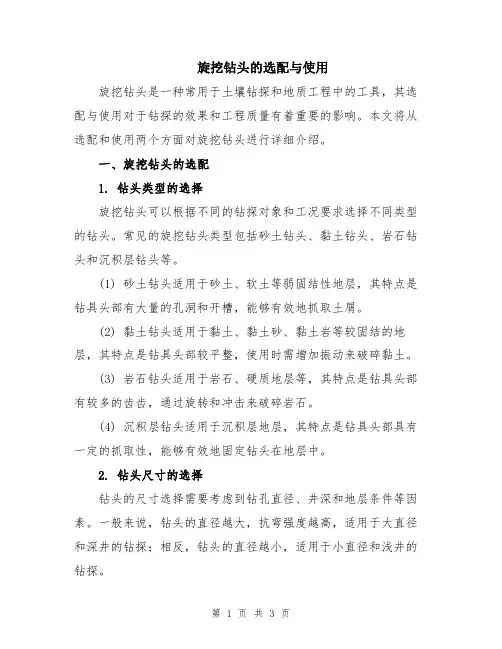
旋挖钻头的选配与使用旋挖钻头是一种常用于土壤钻探和地质工程中的工具,其选配与使用对于钻探的效果和工程质量有着重要的影响。
本文将从选配和使用两个方面对旋挖钻头进行详细介绍。
一、旋挖钻头的选配1. 钻头类型的选择旋挖钻头可以根据不同的钻探对象和工况要求选择不同类型的钻头。
常见的旋挖钻头类型包括砂土钻头、黏土钻头、岩石钻头和沉积层钻头等。
(1) 砂土钻头适用于砂土、软土等弱固结性地层,其特点是钻具头部有大量的孔洞和开槽,能够有效地抓取土屑。
(2) 黏土钻头适用于黏土、黏土砂、黏土岩等较固结的地层,其特点是钻具头部较平整,使用时需增加振动来破碎黏土。
(3) 岩石钻头适用于岩石、硬质地层等,其特点是钻具头部有较多的齿齿,通过旋转和冲击来破碎岩石。
(4) 沉积层钻头适用于沉积层地层,其特点是钻具头部具有一定的抓取性,能够有效地固定钻头在地层中。
2. 钻头尺寸的选择钻头的尺寸选择需要考虑到钻孔直径、井深和地层条件等因素。
一般来说,钻头的直径越大,抗弯强度越高,适用于大直径和深井的钻探;相反,钻头的直径越小,适用于小直径和浅井的钻探。
选择钻头尺寸时还需考虑地层条件,例如如果遇到较坚硬的岩石地层,钻头应选择直径较大、齿齿较少的钻头,以提高钻探效率和钻头寿命。
3. 钻头材质的选择钻头的材质直接影响钻具的切削性能和使用寿命。
常见的钻头材质有合金钢、硬质合金和切割器具等。
硬质合金的切削性能和耐磨性较好,适用于较坚硬的地层;合金钢具有较高的韧性和强度,适用于较软的地层和一般的土壤。
4. 钻头连接方式的选择钻具的连接方式包括直角扣、螺纹连接和销钉连接等多种形式。
选用合适的连接方式需要考虑到钻孔的直径、井深和钻机的具体情况等因素,以确保连接的可靠性和方便性。
二、旋挖钻头的使用1. 钻具存放和保养在使用旋挖钻头之前,需要将钻具存放在干燥通风的地方,防止受潮和锈蚀。
使用过程中,要做好钻具的清洁和保养工作,及时去除沉积在钻具上的泥沙和岩石屑,防止泥沙或坚硬的岩石粒子损坏钻具。
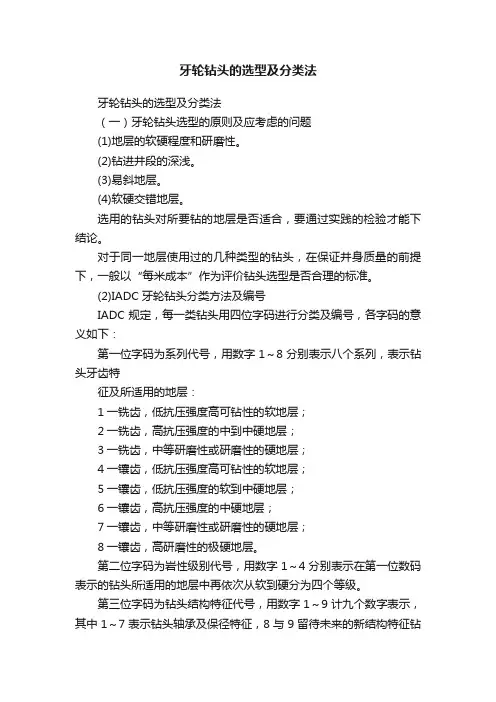
牙轮钻头的选型及分类法牙轮钻头的选型及分类法(一)牙轮钻头选型的原则及应考虑的问题(1)地层的软硬程度和研磨性。
(2)钻进井段的深浅。
(3)易斜地层。
(4)软硬交错地层。
选用的钻头对所要钻的地层是否适合,要通过实践的检验才能下结论。
对于同一地层使用过的几种类型的钻头,在保证井身质量的前提下,一般以“每米成本”作为评价钻头选型是否合理的标准。
(2)IADC牙轮钻头分类方法及编号IADC规定,每一类钻头用四位字码进行分类及编号,各字码的意义如下:第一位字码为系列代号,用数字1~8分别表示八个系列,表示钻头牙齿特征及所适用的地层:1一铣齿,低抗压强度高可钻性的软地层;2一铣齿,高抗压强度的中到中硬地层;3一铣齿,中等研磨性或研磨性的硬地层;4一镶齿,低抗压强度高可钻性的软地层;5一镶齿,低抗压强度的软到中硬地层;6一镶齿,高抗压强度的中硬地层;7一镶齿,中等研磨性或研磨性的硬地层;8一镶齿,高研磨性的极硬地层。
第二位字码为岩性级别代号,用数字1~4分别表示在第一位数码表示的钻头所适用的地层中再依次从软到硬分为四个等级。
第三位字码为钻头结构特征代号,用数字1~9计九个数字表示,其中1~7表示钻头轴承及保径特征,8与9留待未来的新结构特征钻头用。
1~7表示的意义如下:1一非密封滚动轴承;2一空气清洗、冷却,滚动轴承;3—滚动轴承,保径;4—滚动、密封轴承;5一滚动、密封轴承,保径;6一滑动、密封轴承;7一滑动、密封轴承,保径。
第四位字码为钻头附加结构特征代号,用以表示前面三位数字无法表达的特征,用英文字母表示。
目前,IADC已定义了11个特征,用下列字母表示:A一空气冷却;C一中心喷嘴;D一定向钻井;E一加长喷嘴;G一附加保径/钻头体保护;J一喷嘴偏射;R一加强焊缝(用于顿钻);S一标准铣齿;X一楔形镶齿;。
R一圆锥形镶齿;Z一其他形状镶齿。
有些钻头,其结构可能兼有多种附加结构特征,则应选择一个主要的特征符号表示。
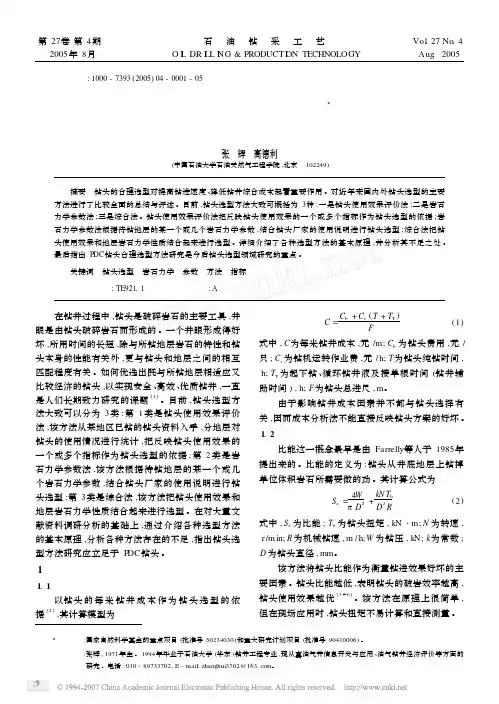
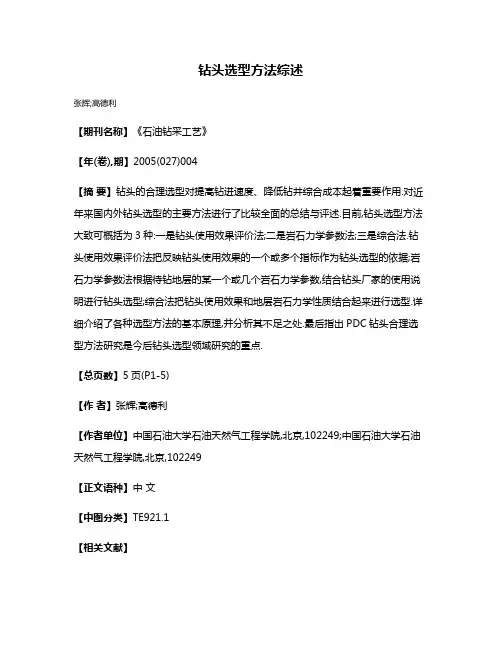
钻头选型方法综述
张辉;高德利
【期刊名称】《石油钻采工艺》
【年(卷),期】2005(027)004
【摘要】钻头的合理选型对提高钻进速度、降低钻井综合成本起着重要作用.对近年来国内外钻头选型的主要方法进行了比较全面的总结与评述.目前,钻头选型方法大致可概括为3种:一是钻头使用效果评价法;二是岩石力学参数法;三是综合法.钻头使用效果评价法把反映钻头使用效果的一个或多个指标作为钻头选型的依据;岩石力学参数法根据待钻地层的某一个或几个岩石力学参数,结合钻头厂家的使用说明进行钻头选型;综合法把钻头使用效果和地层岩石力学性质结合起来进行选型.详细介绍了各种选型方法的基本原理,并分析其不足之处.最后指出PDC钻头合理选型方法研究是今后钻头选型领域研究的重点.
【总页数】5页(P1-5)
【作者】张辉;高德利
【作者单位】中国石油大学石油天然气工程学院,北京,102249;中国石油大学石油天然气工程学院,北京,102249
【正文语种】中文
【中图分类】TE921.1
【相关文献】
1.钻头选型方法综述 [J], 夏广强;
2.钻头选型方法的现状及发展趋势 [J], 白萍萍;步玉环;李作会
3.基于虚拟强度指数的钻头选型方法研究 [J], 陈志学;孙宁;史东辉;王世永;余金海;杨华斌
4.基于岩石抗钻特性的BP神经网络钻头选型方法 [J], 张辉;王昊;姜敞;熊天文;范国宏
5.中石化胜利石油管理局钻井工艺研究院等概钻头选型方法 [J],
因版权原因,仅展示原文概要,查看原文内容请购买。
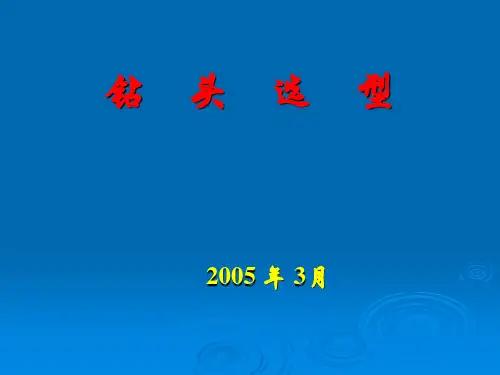
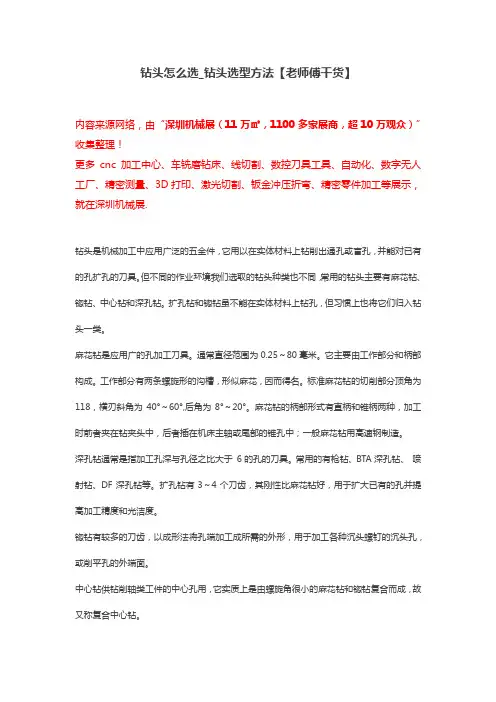
钻头怎么选_钻头选型方法【老师傅干货】内容来源网络,由“深圳机械展(11万㎡,1100多家展商,超10万观众)”收集整理!更多cnc加工中心、车铣磨钻床、线切割、数控刀具工具、自动化、数字无人工厂、精密测量、3D打印、激光切割、钣金冲压折弯、精密零件加工等展示,就在深圳机械展.钻头是机械加工中应用广泛的五金件,它用以在实体材料上钻削出通孔或盲孔,并能对已有的孔扩孔的刀具。
但不同的作业环境我们选取的钻头种类也不同,常用的钻头主要有麻花钻、锪钻、中心钻和深孔钻。
扩孔钻和锪钻虽不能在实体材料上钻孔,但习惯上也将它们归入钻头一类。
麻花钻是应用广的孔加工刀具。
通常直径范围为0.25~80毫米。
它主要由工作部分和柄部构成。
工作部分有两条螺旋形的沟槽,形似麻花,因而得名。
标准麻花钻的切削部分顶角为118,横刃斜角为40°~60°,后角为8°~20°。
麻花钻的柄部形式有直柄和锥柄两种,加工时前者夹在钻夹头中,后者插在机床主轴或尾部的锥孔中;一般麻花钻用高速钢制造。
深孔钻通常是指加工孔深与孔径之比大于6的孔的刀具。
常用的有枪钻、BTA深孔钻、喷射钻、DF深孔钻等。
扩孔钻有3~4个刀齿,其刚性比麻花钻好,用于扩大已有的孔并提高加工精度和光洁度。
锪钻有较多的刀齿,以成形法将孔端加工成所需的外形,用于加工各种沉头螺钉的沉头孔,或削平孔的外端面。
中心钻供钻削轴类工件的中心孔用,它实质上是由螺旋角很小的麻花钻和锪钻复合而成,故又称复合中心钻。
模具制造业的钻削加工在几个关键要素上往往与常规钻削有所不同。
首先,在不规则表面上钻孔的情况很常见;其次,该行业所用的工件材料通常比常规材料更难加工。
为了成功应对这些加工特点,需要采用具有针对性的加工策略。
无论是使用可转位刀片式钻头、可换钻尖式钻头,还是整体硬质合金钻头乃至高速钢钻头,在不规则表面上钻孔或进行断续切削都有可能出现问题,这是因为加工表面越不规则,钻头挠曲变形的可能性就越大。
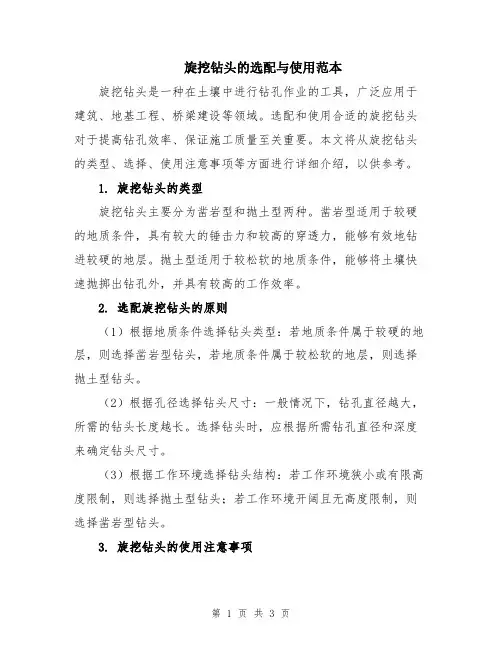
旋挖钻头的选配与使用范本旋挖钻头是一种在土壤中进行钻孔作业的工具,广泛应用于建筑、地基工程、桥梁建设等领域。
选配和使用合适的旋挖钻头对于提高钻孔效率、保证施工质量至关重要。
本文将从旋挖钻头的类型、选择、使用注意事项等方面进行详细介绍,以供参考。
1. 旋挖钻头的类型旋挖钻头主要分为凿岩型和抛土型两种。
凿岩型适用于较硬的地质条件,具有较大的锤击力和较高的穿透力,能够有效地钻进较硬的地层。
抛土型适用于较松软的地质条件,能够将土壤快速抛掷出钻孔外,并具有较高的工作效率。
2. 选配旋挖钻头的原则(1)根据地质条件选择钻头类型:若地质条件属于较硬的地层,则选择凿岩型钻头,若地质条件属于较松软的地层,则选择抛土型钻头。
(2)根据孔径选择钻头尺寸:一般情况下,钻孔直径越大,所需的钻头长度越长。
选择钻头时,应根据所需钻孔直径和深度来确定钻头尺寸。
(3)根据工作环境选择钻头结构:若工作环境狭小或有限高度限制,则选择抛土型钻头;若工作环境开阔且无高度限制,则选择凿岩型钻头。
3. 旋挖钻头的使用注意事项(1)钻孔前的准备工作:清理钻孔周围的障碍物,确保工作环境开阔;检查钻机和钻头的连接是否牢固;确认钻孔位置和深度。
(2)钻孔过程中的控制:控制钻机的转速和下钻力度,避免因钻进速度过快而导致旋挖钻头卡死或损坏;时刻注意钻孔进展情况,及时调整钻进方式和操作参数。
(3)钻孔后的清理工作:钻孔完成后,及时将钻头从钻孔中取出,清理钻头上的土壤和碎石;对于凿岩型钻头,还需要及时更换磨损严重的齿条和壳体。
4. 旋挖钻头的维护保养(1)定期检查钻头的磨损情况,及时更换磨损严重的部件。
(2)依据工作环境和作业情况,适时进行润滑维护,保证钻头的正常工作。
(3)钻孔作业结束后,应对钻头进行清洗和防锈处理,放置在通风干燥的地方,防止钻头受潮生锈。
5. 旋挖钻头的故障处理(1)如果钻头卡死,应立即停机,并通过逆转钻杆的方式将钻头取出,避免损坏钻机和钻杆。
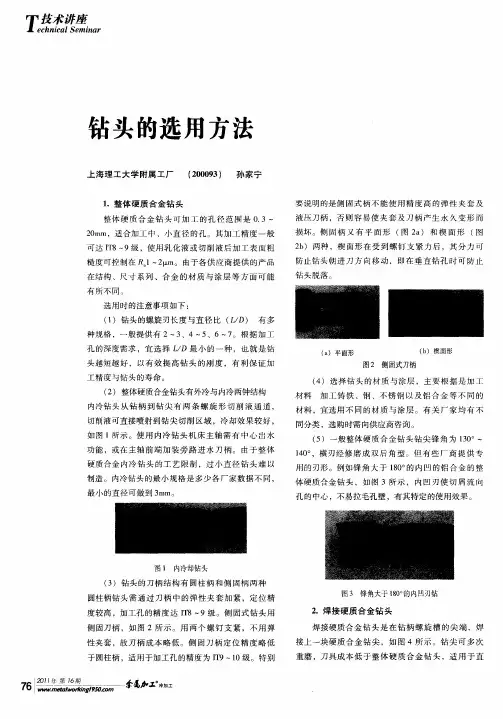
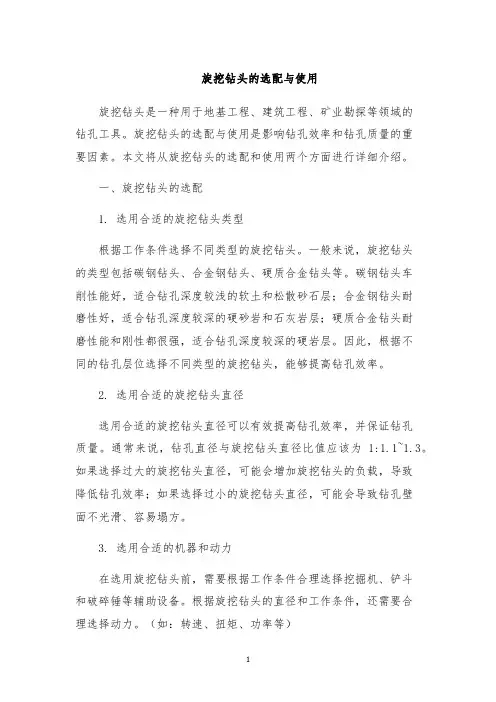
旋挖钻头的选配与使用
旋挖钻头是一种用于地基工程、建筑工程、矿业勘探等领域的
钻孔工具。
旋挖钻头的选配与使用是影响钻孔效率和钻孔质量的重
要因素。
本文将从旋挖钻头的选配和使用两个方面进行详细介绍。
一、旋挖钻头的选配
1. 选用合适的旋挖钻头类型
根据工作条件选择不同类型的旋挖钻头。
一般来说,旋挖钻头
的类型包括碳钢钻头、合金钢钻头、硬质合金钻头等。
碳钢钻头车
削性能好,适合钻孔深度较浅的软土和松散砂石层;合金钢钻头耐
磨性好,适合钻孔深度较深的硬砂岩和石灰岩层;硬质合金钻头耐
磨性能和刚性都很强,适合钻孔深度较深的硬岩层。
因此,根据不
同的钻孔层位选择不同类型的旋挖钻头,能够提高钻孔效率。
2. 选用合适的旋挖钻头直径
选用合适的旋挖钻头直径可以有效提高钻孔效率,并保证钻孔
质量。
通常来说,钻孔直径与旋挖钻头直径比值应该为1:1.1~1.3。
如果选择过大的旋挖钻头直径,可能会增加旋挖钻头的负载,导致
降低钻孔效率;如果选择过小的旋挖钻头直径,可能会导致钻孔壁
面不光滑、容易塌方。
3. 选用合适的机器和动力
在选用旋挖钻头前,需要根据工作条件合理选择挖掘机、铲斗
和破碎锤等辅助设备。
根据旋挖钻头的直径和工作条件,还需要合
理选择动力。
(如:转速、扭矩、功率等)
1。
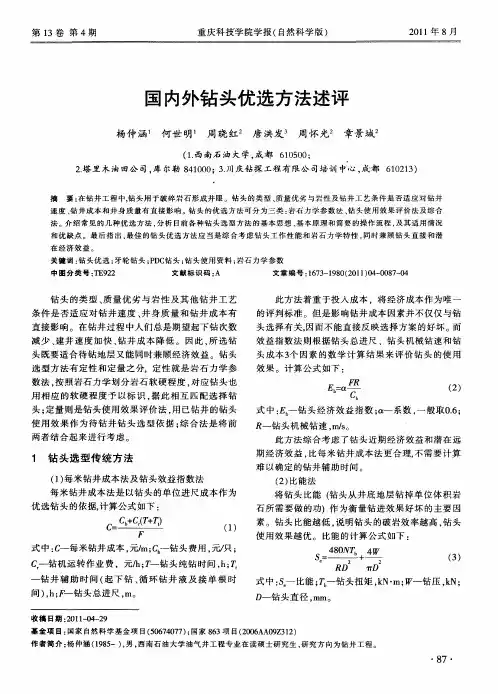
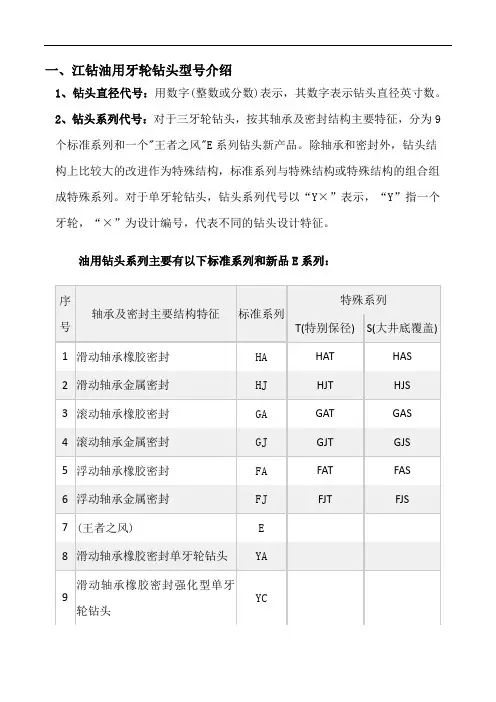
一、江钻油用牙轮钻头型号介绍1、钻头直径代号:用数字(整数或分数)表示,其数字表示钻头直径英寸数。
2、钻头系列代号:对于三牙轮钻头,按其轴承及密封结构主要特征,分为9 个标准系列和一个"王者之风"E系列钻头新产品。
除轴承和密封外,钻头结构上比较大的改进作为特殊结构,标准系列与特殊结构或特殊结构的组合组成特殊系列。
对于单牙轮钻头,钻头系列代号以“Y×”表示,“Y”指一个牙轮,“×”为设计编号,代表不同的钻头设计特征。
油用钻头系列主要有以下标准系列和新品E系列:3、钻头分类号:分类号采用SPE/IADC 23937的规定,由三位数字组成,首位数为切削结构类别及地层系列号,第二位为地层分级号,末位数为钻头结构特征代号。
4、钻头附加结构特征代号:为了满足钻井及地层的某些特殊需要,钻头需改进或加强时,则在分类号后加附加结构特征,采用1个或多个字母表示。
钻头附加结构特征代号见下表:示例:8 1/2HJT537GL钻头8 1/2 :钻头直径为8.5英寸(即215.9mm);HJT:滑动轴承金属密封、特别保径;537:低抗压强度,软至中地层镶齿钻头;G:掌背强化;L:掌背扶正块。
油用浅井牙轮钻头油用浅井牙轮钻头由上海江钻生产,钻头品种齐全,现有从8 1/2″--26″的3个标准系列的近200个品种,其中8 1/2″--12 1/4″适用于2000米以上浅部地层,13 5/8″--26″可适用于极软到极硬的各类不同地层。
油用浅井牙轮钻头型号介绍1、钻头直径代号:用数字(整数或分数)表示,其数字表示钻头直径英寸数。
2、钻头系列代号:对于三牙轮钻头,按其轴承及密封结构主要特征,分为3个标准系列。
除轴承和密封外,钻头结构上比较大的改进作为特殊结构,标准系列与特殊结构或特殊结构的组合组成特殊系列。
油用浅井牙轮钻头系列:江汉三牙轮钻头结构特点如下表:二、江汉三牙轮钻头介绍1、HJ系列三牙轮钻头2、HA系列三牙轮钻头3、FA系列三牙轮钻头结构特点:1、采用浮动轴承结构,浮动元件由高强度、高弹性、高耐温性、高耐磨性特点的新材料制成,表面经固体润滑剂处理。
钻头优选与合理使用技术一、概述在旋转钻井中,钻头是破岩造孔的主要工具,它的质量优劣及其与地层、岩性和它钻井工艺条件的适应程度,直接影响着钻井速度的高低,因而根据地层条件合理选择钻头类型和钻井参数,则是提高钻速、降低钻井成本地重要技术环节。
在深井钻井过程中钻头要钻遇、钻穿多套地层中和多种岩石,由于岩石是具各向异性的非均质体,其品种极多且性质各异,因而从事钻头选型工作研究的石油钻井科技工作者,面对的是一庞大而复杂的集合体。
故钻头类型优选方法的先进性及其所选钻头类型与地层的适用程度,从一定意义上讲制约着深井钻井速度的大幅度提高和钻井成本大幅度下降,是目前国内外钻井工程技术领域相当重视与关注的一项重要研究工作,多年来各国都在下大力,投入大量资金和众多人员进行该方面的试验与研究,以期获取行之有效且能为优质高效钻井提供技术支持的钻头选型方法.石油勘探开发高速度与低成本目标的实现,很大程度上取决于钻井的高速度。
目前国内外畅行的提高钻井速度的主要技术途径,是实施优快钻井配套技术,该项技术的核心内容是由软件技术-高水平的钻井工艺技术和硬件产品-与地层适用性强的高效钻头两部分内容组成。
因而欲求获取钻井的高速度,即实现提高钻井速度、缩短建井周期的工作目的,除应在不断进行钻井工艺技术方面技术创新、研究开发外,另一重要技术途径是注重研制新型钻头和合理选择及使用钻头。
二、国内外相关钻头选型方法综述自钻井应用于探矿工程开始至今,新型钻头研制与钻头选型工作,一直是钻井技术领域中研究的主要课题,随着钻井工艺技术的不断进步与提高,钻头选型方法在不断提高与完善,但此项工作将永远是该项技术领域中研究的主题。
现将国内外有代表性的几种钻头选型方法予以归类综述。
(一)经验钻头选型法本方法俗称现场钻井资料选型法,其提出和应用开始于钻井工程的初始阶段,后经从事石油钻井工程现场施工和科研人员几代人的不断完善提高、逐步形成为一套行之有效的实用方法,目前现场钻井技术人员多采用这一方法选择钻头类型。
钻头选择和用法钻头是钻孔的重要工具,选择适合的钻头可以提高工作效率和质量。
本文将介绍钻头的选择和使用方法,希望对大家有所帮助。
一、钻头的选择1. 钻头的材质不同材质的钻头适用于不同的工作材料。
钻头的材质有高速钢、硬质合金、钻石等。
高速钢钻头适用于钻软质材料,硬质合金钻头适用于钻硬质材料,而钻石钻头适用于超硬材料的钻孔。
2. 钻头的直径钻头直径的选择应该根据钻孔的要求和工作材料的硬度来决定。
对于较硬的材料,需要选用较小直径的钻头,而对于软质材料可以考虑选用较大直径的钻头。
3. 钻头的长度钻头的长度应该根据钻孔深度来选择。
过长的钻头容易折断,过短的钻头不能钻到预期位置。
4. 钻头的形状钻头的形状有直柄、圆柱、锥形等多种形式。
不同形状的钻头适用于不同的钻孔场合。
例如,锥形钻头可以在不同直径的孔中钻出适合的孔洞,而圆柱形钻头可以钻出标准大小的孔洞。
二、钻头的使用方法1. 钻孔前的准备在钻孔前,应该仔细检查钻头的状态。
如果钻头有损伤或磨损,应该更换新的钻头。
同时,需要选用适合的冷却液,在钻孔时往钻孔位置不断滴入冷却液,以保持钻头的清洁,避免过热和磨损。
2. 钻孔时的操作(1)确定钻孔位置和深度。
(2)将钻头与钻机卡口紧固,开启钻机。
(3)将钻头缓慢地放到工作材料上,施加适当的力量,使钻头慢慢进入材料。
要注意钻孔过程中的速度和力度,不要过快或过慢,避免钻头折断或损伤工件。
(4)如钻头进入物料后未见钻头硬度,则需加压,直至水平位置的手掌如果觉得发热uc0一定要停下来,冷却后再继续。
(5)钻孔完成后,应该用冷却液清洗钻头,并及时清理工作面,以免影响下一次钻孔质量。
三、注意事项1. 钻头使用前,应该先检查其是否完好,避免造成损害。
2. 钻头必须保持冷却,以保证钻头的寿命和工作效率。
3. 钻孔时应该使用适当的加压力度,不要过急或过缓。
4. 钻孔完成后应该及时清洗和保养钻头,避免生锈和损坏。
总之,选择合适的钻头和正确的使用方式,不仅可以提高工作效率,还能够保证钻孔质量。
石油钻井的钻头选择与操作流程石油钻井是石油工业中一项至关重要的环节,钻头的选择和操作流程对于钻井作业的效率和质量有着重要的影响。
本文将探讨石油钻井中钻头的选择与操作流程。
一、钻头的选择1. 钻头类型在石油钻井中,常用的钻头类型包括三翼钻头、切削结构钻头和钻进钻头。
三翼钻头适用于软、中硬地层,切削结构钻头适用于硬地层,而钻进钻头则适用于岩石地层。
2. 钻头尺寸钻头尺寸的选择应根据井眼尺寸和井口尺寸来确定。
一般情况下,井眼尺寸的选择应考虑到地层条件以及钻井液的循环能力。
3. 钻头质量选择钻头时需要考虑到钻头的质量。
一般来说,质量较好的钻头具有更长的使用寿命和更好的钻进效果。
因此,选择具有良好声誉和高品质的供应商是至关重要的。
二、操作流程1. 钻头安装钻头安装是钻井作业中的第一步。
首先,需要将钻头与钻杆连接,确保连接牢固可靠。
然后,将钻头从钻井井口降下到井底,同时要注意保持钻杆的直线,以避免出现卡钻等问题。
2. 钻井液的循环钻井液的循环是钻井作业中的关键环节。
循环钻井液可以有效冷却钻头,清除井底层状物和带走地层碎屑,同时还能维持井眼壁的稳定。
在进行循环钻井液时,需要根据井眼尺寸和地层条件调整钻井液的流量和压力。
3. 钻头进尺与转速控制钻头的进尺与转速的控制直接影响钻井的效率和质量。
进尺速度过快可能导致钻头过度磨损或损坏,而速度过慢则会延长钻井工期。
因此,需要根据地层条件和钻头类型合理控制钻头的进尺速度和转速。
4. 钻井参数的监测与调整在钻井作业过程中,需要不断监测钻井参数,并根据监测结果进行相应的调整。
常见的钻井参数包括钻井液的流量和压力、钻井液的循环速度、钻头的进尺速度和转速等。
通过及时监测和调整参数,可以确保钻井作业的安全和高效进行。
5. 钻头更换与维护随着钻井的进行,钻头可能会受到磨损或损坏,需要及时更换。
当钻头磨损到一定程度时,应根据实际情况选择合适的时间进行更换。
此外,定期进行钻头维护同样重要,可以延长钻头的使用寿命和提高钻进效果。
浅谈钻井钻头的优选钻头是钻井工艺的主要工具之一,它直接影响着钻井速度、钻井质量与钻井成本。
在钻井施工中,必须根据工程设计内容,充分考虑剖面类型、地层岩性、地层可钻性等因素,确定钻头类型,以提高地层的适应性。
本文论述了西南石油工程临盘钻井分公司的一些先进做法。
标签:选型原则;选型方法;选型试验1、钻头选型原则钻头选用,必须考虑其关键的影响因素,考虑地层岩性、井身结构、钻具组合、钻井液性能、邻井情况以及期望值和经济评价。
在现场施工中,钻头选型的一般原则是:根据地层特性,选择综合性能良好,使用寿命长,机械钻速高,能适应动力钻具特性的高效钻头。
选用的钻头,攻击性要强、清洗效果好,以提高机械钻速;牙齿耐磨性要好、抗冲击性要强、保径效果要好、耐冲蚀性要强,以延长钻头寿命;轴承密封要好,以延长轴承寿命;钻头导向性要好,以满足井眼要求;稳定性要好,以便钻头工作平稳。
2、常用的钻头选型的方法目前,国内已成功地开发出多种形式的钻头优选方法和技术。
大体上呈现出三大技術发展方向和各自的研究领域,我们通过对其主要技术发展方向的研究,以及对各种钻头优选方法上优劣性的评价,再结合我们实际现场应用状况分析,确定出一种综合性强的钻头优选方法。
西南石油工程临盘钻井分公司常用的钻头选型方法(1)根据邻井资料选型对邻井相关资料逐地层逐钻头进行分析,以最优钻速和进尺为标准,从中选出合适的钻头类型和钻井参数。
(2)根据钻头分类标准选型因各钻头生产厂家所生产的各种类型钻头是根据岩石的软硬特性设计的,这样一来就可根据所钻地层的软硬级别选用对应的钻头类型。
(3)根据统计方法选型一般地,老油区有着丰富的钻头使用资料,对这些资料进行统计分析,得到各类钻头的定量使用指标,如机械钻速、钻头寿命、钻头进尺、每米成本等,根据各项指标的高低进行对比完成钻头选型。
常用的这几种钻头选型方法均依靠室内测定的岩石可钻性,是目前现场采用较为普遍的钻头选型方法。
由于岩石可钻性表征了岩石抵抗钻头破碎的能力,是选择钻头、提高钻井速度的基础,因此这类钻头选型方法在现场应用中具有很强的指导作用。
根据地层特性如何选择合适钻头在选择合适的钻头时,需要考虑地层的特性,以确保钻井作业的高效进行。
地层特性包括地层类型、强度、稳定性、韧性、颗粒度等因素。
下面将针对不同地层特性介绍合适的钻头选择。
1.岩石类型:地层中的岩石类型是选择合适钻头的重要因素之一、常见的岩石类型包括砂岩、灰岩、页岩、花岗岩等。
对于砂岩等软岩地层,常用的钻头为角齿钻头和碎石钻头,其强度较低且易于切削。
对于坚硬的岩石如花岗岩,常用的钻头为锥形钻头和金刚石钻头,其硬度较高且不易损坏。
2.地层强度和稳定性:地层强度和稳定性是选择钻头的另一个重要因素。
对于强度较高的地层,如坚硬饱满的岩石或熟化的混凝土,需要使用硬质合金钻头或金刚石钻头,以提供足够的切削力。
而对于强度较低的地层,如软弱的黏土或松散的砂层,常用的钻头则为碎石钻头和螺旋钻头,其切削力较小。
3.地层韧性:地层韧性指地层的抗折性和抗压性能,直接影响钻头选择。
对于韧性较高的地层,如粘土、泥页岩等,适合使用螺旋钻头和截齿钻头,以提供足够的切削力和排渣能力。
而对于韧性较低的地层,如砂岩和灰岩,适合使用角齿钻头和锥形钻头,切削效果更好。
4.地层颗粒度:地层颗粒度与地层中颗粒的尺寸和分布有关,也是钻井中需要考虑的因素。
对于颗粒度较粗的地层,如砾石、砂砾岩等,常用的钻头为多翼钻头和锥形钻头,以提供足够的切削能力。
而对于颗粒度较细的地层,如黏土、粉砂岩等,适合使用螺旋钻头和截齿钻头,能够更好地清除钻屑。
综上所述,选择合适的钻头需要综合考虑地层特性,包括地层类型、强度、稳定性、韧性、颗粒度等因素。
在实际钻井作业中,钻头的选择既要满足地层特性的要求,又要兼顾钻头的耐磨性、切削效率和经济性。
因此,需要钻井专业技术人员结合具体地层情况,结合相关经验和工程要求,综合分析并选择合适的钻头,以确保钻井作业的顺利进行。
同时,钻头的正常维护和保养也是保证钻头使用寿命和效果的重要环节,应予以重视。
钻头的选购技巧钻头是使用最广泛的切削工具之一,用于钻孔或加工不同材料的工件。
选择合适的钻头对工作效果和使用寿命有着重要的影响。
下面是选购钻头的一些技巧:1.材料类型:首先要考虑需要加工的材料类型,常见的钻头材料有高速钢(HSS)、碳化钨(WC)和立方氮化硼(PCD)。
高速钢钻头适用于加工普通钢和铸铁;碳化钨钻头适用于加工不锈钢和合金钢;立方氮化硼钻头适用于加工复合材料和非金属材料。
根据材料类型选择适合的钻头能够提高工作效率和加工质量。
2.加工目的:根据加工目的选择合适的钻头,如钻孔、扩孔、沉头、倒角等。
不同的加工目的需要不同类型的钻头,例如,中心钻是一种用于加工工件表面中心点的预定位工具;扩孔钻头具有大直径和多刃设计,适用于扩大已有孔洞的尺寸;沉头钻头具有一个圆锥形的尖端,用于沉入工件表面,使螺钉头部与工件表面齐平。
3.直径和长度:根据需要的孔径选择适当的钻头直径,较小的直径适用于细小的孔洞,而较大的直径适用于大孔洞。
另外,还要考虑钻头的长度,因为较长的钻头可以达到深孔加工的需求。
4.刃数和刃角:钻头的刃数和刃角也是影响加工效果的重要因素。
刃数越多,切削力分布越均匀,加工质量越好。
刃角直接影响钻头的切削能力,较小的刃角能够提高切削效果,但可能会降低钻头的强度。
5.涂层和涂料:有许多不同的涂层和涂料可以应用于钻头表面,以提高钻头的耐磨性和切削性能。
常见的涂层包括TiN、TiCN、TiAlN等。
涂层可以提高钻头的使用寿命和工作效率。
6.品牌和质量:选择知名品牌和可靠供应商提供的钻头,可以确保产品质量和售后服务。
精密的制造工艺和高品质的材料可以提供更长的使用寿命和更高的工作效率。
7.价格和性价比:在购买钻头时,不仅要考虑价格,还要综合考虑钻头的性能和耐用性。
选择合适的性价比,以获得最优质的钻头。
8.使用和维护:正确使用和维护钻头也能够延长其使用寿命。
使用时要根据材料类型和加工目的选择合适的转速和进给速度,避免过度磨损和损坏。